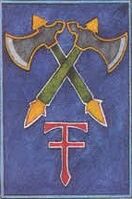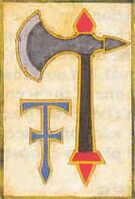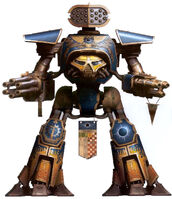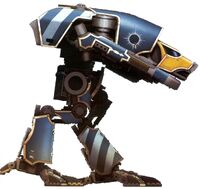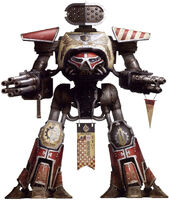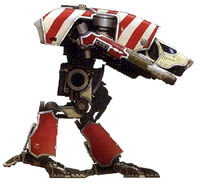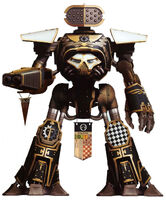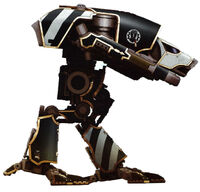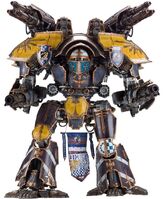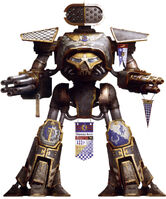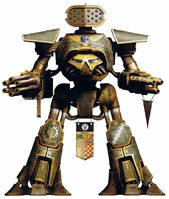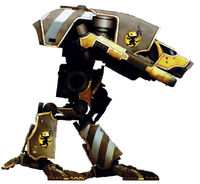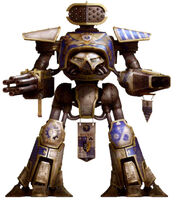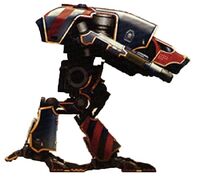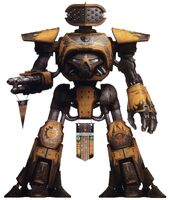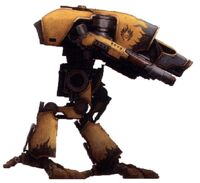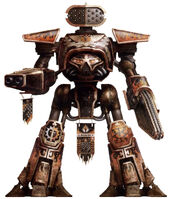"No weapon in the arsenal of the Imperium or the Traitor equals the Titan on the battlefield, and a Legion of such war machines can bring any world to its knees. In truth a Titan has only three enemies: folly, hubris and another of its own kind."
- —Grand Master Volkus, Ordo Sinister, Divisio Militaris, Collegia Titanica during the Horus Heresy
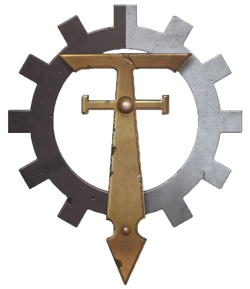
Icon of the Collegia Titanica, also called the Adeptus Titanicus.
The Collegia Titanica is the division of the ancient Mechanicum and the current Adeptus Mechanicus that operates and oversees the Titans, the colossal combat walkers that are the most powerful engines of war in the Imperium of Man.
The Collegia is also more rarely known as the Adeptus Titanicus (a contraction of "Adeptus Mechanicus Collegia Titanica") and as the Legio Titanicus in ancient records dating back to the Great Crusade and the Horus Heresy.
Born of the time during the Age of Strife when the first temples to the Omnissiah were being raised on Mars, the Titans are the personification of the military might available to the Emperor of Mankind.
Bristling with massive cannons and missile launchers capable of wreaking terrible destruction upon an enemy, they dominate the battlefields of the galaxy and are a testimony to the consummate skills of the Tech-priests of the Cult Mechanicus.
Every Titan is part of a larger unit called a Titan Legion or a Titan Order. Each Titan Legion is based on a Mechanicus Forge World and remains under the direct control of the Adeptus Mechanicus, who jealously guard these mighty war machines and have the power to sanction which war zones they will commit their forces to.
It is this power that gives the rulers of the Adeptus Mechanicus much of their influence when it comes to determining when the armies of the Imperium will fight. It is a power which is coveted by other factions on Terra -- especially the priests of the Ecclesiarchy, who would dearly love the reliable support of Titans for their Wars of Faith.
The Titan Legions of the Adeptus Mechanicus are amongst the most powerful military entities within the Imperium of Man. Ancient and implacable, Titans are colossal engines of war, massive robotic combat walkers the size of multi-story buildings rightly known as "god-machines" or "god-engines" to the Tech-priests, who revere them as the physical embodiments of the Machine God.
Even the smallest class of Titan is mighty enough to destroy an entire tank squadron in a span of seconds or level a city block. Each Titan Legion is its own ancient warrior order inextricably linked to the Forge World (or worlds) on which it is based.
The Titan Legions are fierce and proud, each with its own historic alliances and rivalries, and its own unique character that makes it somewhat similar to its counterparts amongst the Chapters of the Adeptus Astartes or the houses of the Imperial Knights.
History
"We are all but a weapon in the right hand of the Emperor."
- —Exhortations Principiis Titannorum, Divisio Militaris, Collegia Titanica
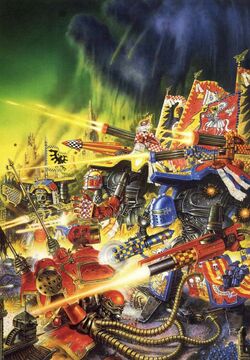
Loyalist Titans of the Collegia Titanica holding the line against Traitor Titan Legions.
One of the most ancient pillars of the Adeptus Mechanicus, the Collegia Titanica operates the mighty Titans, each a bipedal metal giant armed with weapons able to level entire cikty districts, and protected by armour and void shields capable of shrugging off attacks from all but the heaviest of foes.
Though few in number compared to the uncountable hosts of the Great Crusade, the Titan Legions fought at the forefront of the Imperium's expansion, carrying the light of Unification to the benighted worlds of Mankind. The so-called "god-engines" of the Titan Legions have served Humanity since the Age of Strife, though their true origins remain lost in the Dark Age of Technology.
Fall of the Old Empire
During the Age of Terra the Human race advanced beyond its ancient pre-industrial past to obtain spacefaring capability. In this ancient time, Mankind slowly and painstakingly began to settle the habitable worlds in its own solar system and in the neighboring star systems near its homeworld using massive starships capable of only sublight speeds.
Mars was one of the first colony worlds to be settled by Humanity, if not the first. Hundreds, then thousands more were to follow during the period of Human history that would become known later as the Age of Technology. For twenty-five standard millennia Mankind ruled the stars, tamed them, and bent them to its will. Wonders beyond imagining were commonplace in this age and no miracle of technoarcana was beyond Human skill. The worlds of Humanity were like silvered jewels that glittered among the firmament, and Mankind held in its hands the means to sunder reality itself or to remake it to the mould of its thoughts.
Only the haughty Aeldari and, long before them, the cold-blooded Slanni, had stood higher in the ranks of creation, and like the domains of those once-mighty ancient civilisations, Humanity's utopian interstellar realm would not last.
Some archeodata available to the Adeptus Mechanicus suggests that the fall of Humanity's old empire was precipitated by the spontaneous manifestation of species-wide psionic abilities and the widespread emergence of Human psykers; some fragmentary surviving records relate a massive invasion of Human space by myriad alien species. Other archives record a galaxy-wide Warp Storm which sundered the commerce and communication of the worlds of Mankind. Others still relate that the sentient machine intelligences created by Humanity as soldiers and servants, which Humanity had come to rely on in all matters, rose up in the Cybernetic Revolt and laid Human civilisation low on every world across the entire empire in a single moment of horror.
In truth, it is most likely that all of these events occurred. Certainly, when the fall came, its onset was swift. When the killing blow of Human interstellar civilisation landed, it was delivered by many hands. Paradise was lost, in no small part through the hubris and weakness of those men and women who had misused what the Cult Mechanicus would later believe were the sacred gifts of advanced technology.
Whatever the causes, at a stroke, the once galaxy-spanning empire of Humanity collapsed into anarchy, insanity and death. Those Human-settled worlds not swallowed up by the raging Warp were consumed by slavering alien nightmares. Those not torn apart by the hands of their own machine servants were laid low by their own, a cannibalistic rage that consumed formerly enlightened peoples as their economic and social conditions suddenly collapsed.
It is even said that great swathes of Humanity were enslaved at this time to the will of unknowable, malevolent intelligences born of the Warp itself, that reality which Human FTL-capable starships relied upon to traverse the vastness of space, "possessed" as Humanity's distant ancestors would have understood it.
Interstellar travel and communications became erratic as the Warp Storms became more frequent and more intense as the birth pangs of the Chaos God Slaanesh roiled the Immaterium. The use of Warp-Drives and astropaths to tie together Human-settled space became increasingly useless during this time. Billions eventually died as a result of the wars, renegade psykers, daemonic possessions and starvation that ran rampant in this dark period.
Across the galaxy, the light of civilisation was extinguished. The greater part of Humanity was slain by the various calamities and the fraction that remained were plunged into an age of anarchy, savagery and insanity that would rage across the galaxy for some five Terran millennia.
This was the Age of Strife, and never was an era of Human history so aptly titled.
Old Night
Even Old Earth, the cradle of Humanity, where the Age of Strife was better remembered as "Old Night," fell during that darkest of epochs, her oceans boiled away and her great cities burned to ashes by the constant wars for control of shrinking resources and the use of once-unthinkable weapons of mass destruction. Humanity's finest were rendered to mindless savages. Blood-maddened primitives remembered as "techno-barbarians" used artefacts of high technology as blunt clubs to brain one another to death amidst the shattered ruins of their forefathers' glory, ignorant of the inheritance denied them.
Mars, the red planet which had long served as Humanity's wellspring of scientific advance and technological wonder, was not spared the chaos. Yet here some vestige of order, perhaps the last shred of rationality remaining to the entire species, was saved. In the midst of a world of shattered, advanced machines, whose leaders could no longer acquire sufficient food or resources to accommodate its large population even as the terraforming protocols that had kept Mars habitable broke down, the preservation of life came to depend upon the preservation of knowledge.
The smallest scrap of ancient technical knowledge meant the difference between extinction and survival on a world whose once carefully constructed biosphere was in the process of unravelling before its people's eyes. Thus, in time, those able to coax some ghost of functionality from the vast metal corpses among which Mars' population clung to life came to be regarded as prophets of the most sacred data.
And so too did the vessels of such knowledge come to be seen as holy. The mechanisms by which data was preserved, processed and transmitted became themselves objects of religious veneration -- the most holy of holies. Machines capable of cognition were of utmost value, yet they were known to be in equal part dangerous. The custodians of knowledge on ruined Mars preached the sanctity of the machine even as they remained vigilant against the return of true self-awareness, ever fearful that the thinking machines might again turn upon what remained of Humanity as they had at the dawn of the Age of Strife.
And thus, amidst the ruins and wreckage of an advanced civilisation scattered across the reborn oxide-red deserts of Mars, Mankind set the first foot upon the long and arduous march to redemption. Over countless generations, the custodians of the machines gathered together what scattered remnants of advanced technology they could recover from the dangerous Martian wastes, composing a canon of knowledge that formed the basis of a new religion -- the Cult of the Machine.
Blessed with secrets yet denied the bulk of what remained of Humanity, these so-called "Tech-priests" raised great foundries or "forge cities" across the surface of the Red Planet and from them soon flowed a torrent of machines, artifices, instrumentations and weapons of every conceivable form and function, from microscopic nanyte war-swarms to towering, armoured robotic giants that were capable of destroying entire cities.
This Cult Mechanicus, dedicated to the animistic worship of the deity they named the "Machine God" and under the direction of the faith's rigid hierarchy of Tech-priests, set about restoring order to their world. The Titan Legios themselves came into being on Mars during the anarchy of Old Night, when the fabled Triad Ferrum Morgulus was established.
This trio of nascent Titan Orders consisted of the Legio Tempestus, Legio Mortis and the Legio Ignatum, and while all three stood against the horrors of Old Night that plagued Mars, from ravening xenos to thinking-machine aberrations, they were just as equally likely to fight one another; for each served the interests of its home forge city above all else, so that throughout the long age of anarchy, rivalries were established that much later would bear bitter fruit indeed.
The Tech-priests of Mars built their first temples to the Machine God and eventually restored order to the Red Planet as the Age of Strife continued to consume other Human worlds. They established a new planetary government led by the leading magi of the Cult Mechanicus that was known as the Mechanicum, which was led by a senior Tech-priest given the title of the "fabricator-general" of Mars.
Treaty of Mars and the Great Crusade
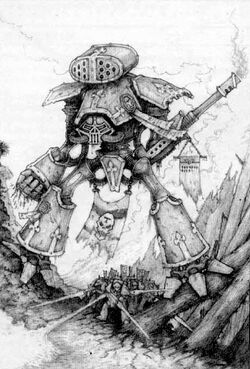
Reaver-class Battle Titan supporting an advance by the Space Marines.
Perhaps inevitably, there followed a period of outright war as rival sects of Tech-priests sought supremacy, whether doctrinal or temporal, but at length, an uneasy balance of power was achieved, although schisms, heresies and betrayals remained constant.
An internecine web of power, patronage and influence came to bind the warring Mechanicum factions together, until eventually the Tech-priests of Mars were sufficiently united in purpose to expand their power beyond the Red Planet, beyond the Sol System, and out into a galaxy still riven by Warp Storms and preyed upon by monstrous Human tyrants and xenos fiends.
No archive recalls the details of every Mechanicum colonisation ark sent forth into the darkness, but it is likely that their failure rate was astronomically high and that millions of Tech-priests and Martian colonists perished during this so-called "Long March." Nonetheless, some colony vessels did reach their target worlds through the Warp by luck or other circumstance and thus were the seeds of the Cult Mechanicus scattered across the galaxy.
Some of these colony worlds would at length grow to become true "Forge Worlds," akin to Mars and yet in many cases possessed of their own variation of culture and cult ritual shaped by their own unique historical and environmental realities. Others became more of the so-called "Knight Worlds," colonies established on planets that were rich in resources and which would one day feed and sustain the ravenous appetites for food and resources of the Forge Worlds themselves.
In time, the great Warp Storms which had divided the galaxy were dispelled as the 30th Millennium dawned after the Fall of the Aeldari and the birth of the Chaos God Slaanesh. At last, the rebirth of Humanity could begin. The powerfully psychic being known only as "the Emperor" led His followers against the tyrants of Old Night and during the subsequent Unification Wars finally united all the peoples of Old Earth -- now called Terra -- under one government for the first time in five standard millennia.
Some say that the Tech-priests of Mars had long observed the scattered techno-barbarian tribes of Old Earth, watching them from afar as this great warlord arose from the multitudes of the techno-savages to unite those who would heed His message, and conquer those who would not. As He gained in power, the Tech-priests grew jealous of this distantly-observed individual and the mastery of technology He, above all the other petty warlords of Terra, so obviously possessed. And as His armies and His power grew, they knew that their irregular sorties to recover lost technological wonders from the ruins of Old Earth had come to an end.
A genius the likes of which Mankind had never witnessed, the Emperor created the transhuman Space Marines of the Legiones Astartes and set above them His superhuman gene-sons -- the primarchs -- who would lead Humanity into a long-planned-for age of reconquest that would become known as the "Great Crusade."
It was upon the slopes of the greatest mountain on Mars, Olympus Mons, that this man, if such a label could truly be applied to Him, the Emperor of Mankind, first set foot upon the Red Planet. Mars was the first Human colony He had encountered beyond Mankind's homeworld. Heralded by all those on Mars who met Him as the Omnissiah, the physical incarnation of the Machine God, some within the Cult Mechanicus were not entirely pleased with this turn of events. A few of these malcontents incited a short and bloody insurrection against the majority of those within the cult who called for an alliance with the Emperor, but eventually the opposition was crushed and Mars and Terra were finally reunited after millennia of separate development by the agreement called the Treaty of Mars in the late 30th Millennium.
This accord formally founded the Imperium of Man as an alliance between Terra and the ancient Mechanicum government of Mars, and granted the latter the autonomy required to maintain their faith even as the Emperor intended to spread His secular and atheistic Imperial Truth across the galaxy. Upon Olympus Mons the lords of the Red Planet ascended to their place alongside the Imperium of Man, but the Mechanicum would ever remain an empire within an empire, for machine domains other than Mars existed across the galaxy and would in time swear fealty to the fabricator-general of Mars.
In recognition of the fact that the Unification of all Humanity could not be achieved without the technological and scientific aid of the Mechanicum, Mars became an ally to Terra rather than her subject. With the massive Human resources of Terra and the colossal technical and industrial power of Mars, the Emperor could begin His mighty enterprise of reconquering the galaxy on a firm foundation. Many long-forgotten Human-settled planets were liberated and many more worlds were settled anew. Thus began the Great Crusade, and over the next 200 Terran years the Imperium of Man rapidly expanded across the galaxy.
As the Emperor's hosts pushed ever outwards into the galaxy, casting back the horrors that had gripped the scattered Human worlds for so many long centuries, the Titan Legions marched with them. Fighting alongside the transhuman Space Marines of the Legiones Astartes, the elite void-soldiers of the Solar Auxilia and numerous other forces in the rapidly expanding Excertus Imperialis, the Titan Orders came upon other planets dominated by their long-lost kin, Forge Worlds not unlike Mars and ruled by similar techno-theocracies dedicated to the Machine God who had settled these worlds after being sent out by Mars into the interstellar void during Old Night.
A few refused to acknowledge the primacy of the Red Planet over their variants of the Cult Mechanicus and had to be forced to submit, or in some cases were even destroyed. The majority however knew of the Red Planet through the few fragments of archive data and echoes of legend which had managed to survive after the settlement of their worlds during the Age of Strife, and willingly took their place in the new order.
Titan Legions
"We are the iron fist of the Machine God. We are above all. Above the orders of Terra, and of Mars. We are beyond the command of our Forge Worlds. By ancient design, we are independent, to avoid ensnarement in the politics of men. We safeguard the domains of the Cult Mechanicus as we see fit. We agree to audience for petitions for aid, and grant our might according to our own will upon the petitioners' merits. We are not told."
- —Princeps Senioris Mohana Mankata Vi , "Great Mother" of the Legio Solaria
Myriad were the hosts of the Mechanicum who swore their allegiance to the Great Crusade, from the bellicose Myrmidon cults to the cybernetic flesh-constructs of the Lacrymal. Mightiest of them all, however, were the god-engines of the Collegia Titanica, a singular martial class within, and simultaneously quite distinct from, the standard ranks of the Cult Mechanicus.
The towering bipedal god-engines known as "Titans" have served the Tech-priests of Mars since the time referred to only as the Era of Pathogenesis in the Age of Strife. Though little date from this time survived the millennia, it is known that Titans first appeared during a great and terrible conflict fought between the besieged forces of the nascent Mechanicum and a debased caste of cabalistic heretics named the "Cy-Carnivora."
Vast swathes of the blasted red wastes of Mars had fallen to the Cy-Carnivora Mekwrights and it took the creation of three entire Titan Orders of what would become the Collegia Titanica to defeat them. These three Titan Orders were collectively named the "Triad Ferrum Morgulus," and it was from the template of their creation that all future Titan Orders were founded.
Created to defeat the monstrous hunger-engines of the Cy-Carnivora, little could stand before a Titan, and nothing before an entire Titan Order, which at its height might number between 200-300 towering engines of destruction. Having finally driven the horrors of Old Night from Mars, the Titan Orders were frequently fielded in the service of one forge city against another in a series of internecine civil wars and religious schisms, which seeded enmities that would bear bitter fruit in the dark times to come.
When at length the Emperor came to Mars and the Treaty of Mars was sworn at the great Martian mountain of Olympus Mons, the Titan Orders were turned to the service of the Great Crusade where their devastating weaponry, impregnable armour and the peerless skill and devotion of their pilots proved every bit as destructive against recalcitrant Human empires and xenos horrors as they had against the Cy-Carnivora.
As the Great Crusade expanded ever outwards from Terra, the hosts of Humanity encountered numerous Human-settled worlds. Many were possessed of only the basest technologies, while a few were the equals of Mars itself. Thus were discovered the colonies sent forth by the Mechanicum into the void during the Long March of the Age of Strife.
Such was the deep-rooted imprint of the Cult Mechanicus that, even separated by long, lonely millennia and tens of thousands of light years, these autonomous machine-domains recognised and acknowledged a manner of fealty towards the Mechanicum of the Red Planet. While each of these Forge Worlds would remain sovereign, until much later at least, each swore powerful oaths to the Tech-priests of Mars in shared veneration of the Omnissiah.
The greatest of the newly-discovered Forge Worlds were found to host their own Titan Orders, and while many had developed their own unique and sometimes idiosyncratic cultures, others were discovered to have organised themselves along a similar line to the original Martian Triad Ferrum Morgulus, suggesting some underlying machine principle or pattern at work, which the lords of Mars looked upon and found pleasing. Of the lesser Forge Worlds not possessed of the necessary templates, resources or expertise to construct and operate their own Titans, Mars favoured those who swore fealty with such patronage that they might do so.
Within scant solar decades of the outset of the Great Crusade, the Mechanicum had discovered or founded a score of Titan Orders, and by the turn of the first century of the Great Crusade, the orders of battle by which the Titan Legios arranged themselves had become somewhat codified, and while individual bodies exercised considerable variation in strategy, a degree of standardisation was evident.
The fabricator-general of Mars proclaimed that the many Titan Orders should be recognised as a distinct class within the greater corpus of the Mechanicum, that its doctrines, traditions and battle honours might be propagated and preserved for the good of all Mankind. This body was to be known as the Collegia Titanica, and while the Legios themselves would remain subservient to the will of the individual forge lords, it would soon become a politically influential entity within the emerging structures of the nascent Imperium of Man.
The Collegia Titanica came to rate the strength of each Titan Legion according to a complex formula that allotted each a "militaris" grade. First tier designations ranged from primus to denarii, with a range of further clausal numerical definitions describing the Legio's specific capabilities, specialisations and other characteristics. Though it rarely told the whole truth, the most obvious measure of a Titan Legion's strength was ever the number of god-engines it could field, with the largest maintaining as many as 200-300, while the smallest might be able to muster barely a dozen.
In reality however, the mixture of Titan classes was a far more reliable indicator of potency of a Legio than raw numbers. Few indeed could field the colossal Imperator-class, while almost all fielded significant numbers of Warhound Scout Titans, the lightest common god-engine, with the ubiquitous Warlord, the standard Battle Titan, a proven and powerful design which made up the bulk of most Legios' main strength. There were many other classes besides, notably the ancient Reaver and several Warlord variants such as the Nemesis and Nightgaunt and other, rarer chassis whose designs such as the Apocalypse, Carnivore and Komodo were unique.
Many Titan Legions had a particular mix of god-engines they preferred to commit to battle, exemplifying their own specific battle doctrines. The Legio Audax, also known as the "Ember Wolves," for example, fielded a large number of Warhound Scout Titans, employing them as fast-moving hunting packs that were fearsomely effective at harrying and bringing down far larger enemy engines. Most Legios however, sought to maintain a balanced and flexible force able to prosecute a wide range of operations and confront many different foes.
Though some Titan Legions used their own vernacular, the Collegia Titanica enforced an overall degree of standardisation in unit nomenclature. Depending on their role, Titans were fully capable of operating individually, and often did so when supporting conventional Imperial ground units.
In practice, they were often deployed in formations of anything from two to ten god-engines, but broken into formal units known as a "maniple" comprising five god-engines -- the numeral 5 having an occult and numerological signifier of destruction in many numiscantic systems of prognostication favoured by the machine cult. The most senior Titan commander -- or princeps -- was appointed as the maniple's leader and this force was considered sufficient to prosecute all but the most apocalyptic of battles.
By the height of the Great Crusade at the dawn of the 31st Millennium, dozens of Titan Orders marched to war in the name of the Emperor. The Collegia Titanica on Mars served as overall repository for the martial traditions and templates of the Titan Orders, though in reality each was in effect its own master. By the auspices of the Collegia Titanica, each Titan Order assumed its own title, including both High Gothic and Low Gothic monikers, icons, banners, colours and other unique elements of heraldry.
Horus Heresy
The Great Crusade continued to expand outwards, until the Imperium encompassed nearly the entire galaxy by the early years of the 31st Millennium. At that time, a new and unexpected threat emerged to challenge Humanity's dominance over the galaxy. This was the rebellion against the rule of the Emperor that would be known to later ages as the Horus Heresy.
This revolt was instigated and led by the Warmaster Horus, the greatest and most beloved of the Emperor's sons, the transhuman primarchs who served as His generals, governors and proconsuls. The rebellion began with Horus' virus-bombing of those Space Marines whose loyalties to him were suspect on the world of Istvaan III, and soon took hold amongst half of the Space Marine Legions and many of the Titan Legions serving under the command of the Warmaster, until nearly one third of the entire armed forces of the Imperium had sworn their allegiance to the Traitors.
Schism of Mars

The fabricator-general of Mars at the time of the Horus Heresy, Kelbor-Hal.
It is not entirely clear how Horus managed to turn such a significant percentage of the armies under his command against the Emperor, but he was known to be a very skilled and persuasive leader who commanded immense personal loyalty amongst his subordinates. But even before the opening stages of his planned insurrection occurred, he knew he would have to secure the support of the Mechanicum and their superior technology and weapons if he was to defeat the Emperor and conquer the galaxy.
Horus won over the loyalty of many of the Mechanicum's Tech-priests after promising them the lost secrets of ancient Standard Template Construct (STC) technology that had been recovered from the worlds of the recently subjugated Auretian Technocracy by the Sons of Horus Legion.
The political climate on Mars was full of discontent during this tumultuous time. There were tense relations between the various Techno-magi with sporadic outbreaks of espionage and violence being committed against the various forge cities that represented the primary sociopolitical units of Mars. There were even unconfirmed suspicions that the Titan Legions had already secretly chosen sides in case of a potential civil conflict.
Regulus, the Mechanicum's representative to Horus' 63rd Expeditionary Fleet who had already thrown in his lot with the Warmaster's cause, was sent to the Red Planet to secure the tentative support of the fabricator-general of Mars and the overall leader of the Mechanicum, Kelbor-Hal. Regulus convinced the fabricator-general of Horus' resolve to support increased autonomy for the Mechanicum against the autocratic rule and technological restrictions of the Emperor.
As a show of his appreciation for the fabricator-general's support, Horus provided information to Kelbor-Hal that allowed the Mechanicum to open a repository of forbidden knowledge known as the Vaults of Moravec, which had been sealed for nearly a thousand Terran years.
The Emperor Himself had decreed that the vaults never be opened, for they contained innumerable artefacts of ancient technology that had been fashioned or corrupted by the malign power of Chaos in ages past. But the deal was struck, and the fabricator-general accepted Horus' proposal and joined forces with the Warmaster, assisting the Traitors with all of the most advanced technology of Mankind at his disposal.
When this repository was reopened, there was all manner of forbidden arcane knowledge and weaponry that had obviously been tainted by the corrupting influence of Chaos stored within. Soon the corruption spread throughout the forge cities and temples across the Red Planet as scrap code -- Chaos-contaminated digital source code that was infected with an arcane computer virus -- infested the logi-stacks and cogitator (computer) archives of the Mechanicum, causing literal Chaos to emerge in any cogitator system that was networked to one of its infected counterparts.
The fabricator-general and his Dark Mechanicum allies used this disruption to marshal the strength of their forces, intent on bringing the rule of Mars firmly under their control. Infected by this vicious scrap code, the Titans of the Legio Agravides and the Legio Fortidus met their end when their reactors went critical and exploded, destroying their fortresses and eliminating these once-proud Titan Orders from the roster of Loyalist forces. In later years, this night would become known in Mechanicum legends as the "Death of Innocence."
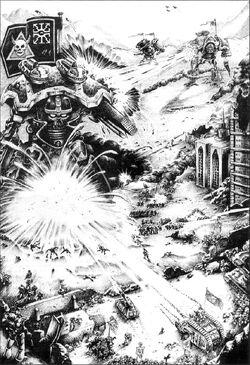
A Warlord-class Titan of the Legio Mortis clashes with the Legio Tempestus during the Horus Heresy.
Later histories would record that the first blow of the Martian civil war was struck against Magos Mattias Kefra, whose forge city in the Sinus Sabaeus region was housed within the Madler Crater. Titans of the Legio Magna marched from the southern Noachis region and within solar minutes had smashed down the gates of Kefra's forge.
Howling engines daubed in red, orange, yellow and black, decorated with flaming horned skull devices, ran amok within the high walls of the crater, crushing everything living beneath them and destroying thousands of standard years of accumulated wisdom in a fury of fire. Vast libraries burned and weapon shops that served the Imperial Army troops of the Solar Guard were reduced to molten slag as the indiscriminate slaughter continued long into the night, the Legio Magna's trumpeting warhorns sounding like the atavistic screams of primitive savages.
Amid the Athabasca Valles, the war machines of the Legio Ignatum and the Burning Stars Titan Legion fought in bloody close quarters through the teardrop landforms caused by catastrophic flooding in an earlier, ancient age of the Red Planet. Neither force could gain the advantage, nor could either claim victory, so after a night's undignified scrapping, both withdrew to lick their wounds.
Along the borders of the Lunae Palus and Arcadia regions, what previously had been simply a heated debate between the partisans of the Emperor and Horus erupted into outright civil warfare as Princeps Ulriche of the Death Stalkers unleashed his war engines upon the fortress of Maxen Vledig's Legio Honorum.
Caught by surprise, the Legio Honorum lost nineteen Titans in the first solar hour of battle, before withdrawing into the frozen wastes of the Mare Boreum and seeking refuge in the dune fields of Olympia Undae. Their calls for reinforcement went unanswered, for all of Mars was tearing itself apart as the plague of civil war spread across the planet in a raging firestorm, a conflict known as the Schism of Mars by later generations.
The fabricator-general's betrayal had only begun to unfold, and would soon see the Dark Mechanicum and the Traitor Titans of Mars joining Horus in open war against the Emperor on Terra itself.
Siege of Terra
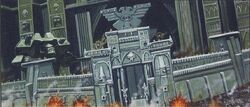
The Traitor Legions lay siege to the Imperial Palace.
The Siege of Terra by the Traitor forces of Horus began in 014.M31 with an orbital bombardment by the Warmaster's fleet as the prelude to invasion. After solar days of shelling, the Heretic Astartes of the Traitor Legions landed on the surface of Terra in Drop Pods and advanced on the two spaceports nearest the location of the Imperial Palace to secure them in preparation for the main landings of the Traitor forces.
Elements from five of the Traitor Legions participated in the battle, aided by Traitor forces already on the surface. Despite the brave efforts of the Loyalists, the Eternity Wall and the Lion's Gate Spaceports fell within solar hours to the Traitors. With them secured, Horus' remaining troops in the Traitor Legions and their Traitor Imperial Army and Dark Mechanicum support forces landed en masse, and the hulking transports carried thousands of troops each. They also brought to the battlefield the terrible Traitor Titans that served the Warmaster's cause and had been infected with the daemonic spirits of Chaos.
The transports' immense size made them prime targets for Terra's Defence Lasers. Although many of the Traitor landing craft were destroyed in-atmosphere, notably the transport vessel carrying the Legio Damnatus, many more made it to the surface, disgorging yet more soldiers, main battle tanks and Traitor Titans to add to the besiegers' strength. They met stiff resistance from the Loyalists as the Imperial defenders knew that the survival of their homeworld, their Emperor, and the entirety of the Human race rested on their shoulders.
The siege of the Imperial Palace then began in earnest. Three times the forces of Chaos scaled the walls, and three times were hurled back by the defenders. Frustrated at this lack of progress, Horus granted the Legio Mortis ("Death's Heads") the singular honour of breaching the walls of the Imperial Palace, amongst whose defenders were the Loyalist Titans of the Collegia Titanica and the Death's Heads' hated rivals -- the Legio Ignatum.
Using the many powerful weapons at their disposal, they eagerly set about the task. By virtue of their insane fury they accomplished this near-suicidal endeavour, despite suffering the losses of over thirty Titans in one evening of fierce fighting. The Chaos Warlord-class Titans broke the outer walls and let inwards a flood of Traitors.
But ultimately, the Traitors' assault failed as the final events of the Heresy played out aboard Horus' own flagship, the Vengeful Spirit. The Emperor triumphed during the confrontation between Himself and the Chaos-corrupted Warmaster, but only at the cost of His own mortal wounding. The majority of the Traitor Legions scattered following this disastrous defeat, and the Imperial forces gave chase, unleashing the period known as the Great Scouring. Hunted and pursued, system by system, the Traitor Legions and the Traitor Titan Legions eventually were driven into the Eye of Terror and the worlds they had occupied were reconquered by the Imperium.
Post-Heresy
Following the Horus Heresy, the Collegia Titanica continued to serve the Mechanicum, now the reformed Adeptus Mechanicus, and the Imperium, bringing its might to bear where it was deemed required. Throughout the Heresy, past rivalries between certain Titan Legions were aggravated into outright hatred once they found themselves on opposing sides. For millennia after the great conflict the Loyalist Titan Orders continued to battle the surviving Traitor Titan Legios at every opportunity, and one of their most significant assignments was bearing vigil over the Eye of Terror and guarding Imperial space from Chaos raids and Black Crusades.
The Collegia Titanica also protects the Imperium from xenos incursions and other threats. Although as a result of their political autonomy as part of the Adeptus Mechanicus they are generally not concerned with any internal political quarrels that may occur between the Imperium's sometimes competing adepta, they do at times interfere at the behest of their Mechanicus masters, whatever their motives may be.
Notable Campaigns
Horus Heresy
- Battle of Isstvan III (005-006.M31) - The Warmaster Horus revealed the terrible scale of his treacherous ambition and the destruction wrought by the battles of the Horus Heresy to come when he engineered the betrayal of the Loyalist Space Marines at Isstvan III, purging his own and three other Space Marine Legions of those Astartes who could not be relied upon to swear to his cause to overthrow the Emperor of Mankind. The slaughter is made all the more terrible by the Warmaster's alliance with the Legio Mortis ("Death's Heads"), the Legio Audax ("Ember Wolves") and the Legio Vulpa ("Death Stalkers"), whose god-engines are impervious to the Life-Eater virus unleashed against the betrayed Astartes, and which stride through the firestorms that result from the virus-bombing of that world as if they were the towering and vengeful giants of ancient legend.
- Schism of Mars (005-006.M31) - Kelbor-Hal, the fabricator-general of Mars, declared the secession of Mars from the Imperium and the ancient Mechanicum's rejection of the Emperor of Mankind as the Omnissiah in a planet-wide betrayal co-aligned to that of the Warmaster Horus at Isstvan III. Led by the Legio Mortis ("Death's Heads"), the Traitor Mechanicum, later called the "Dark Mechanicum," scoured the surface of the Red Planet of those still loyal to Terra, plunging the first and most important Forge World of Mankind into a bitter civil war that saw the extinction of several ancient Collegia Titanica Legios and dozens of Knight houses. The last to fall were the Loyalist hold-outs of the Legio Tempestus ("Stormlords"), who, perhaps mercifully, died unaware that the bulk of their Legio off-planet had renounced their oaths to the Emperor and declared for the Warmaster.
- Drop Site Massacre of Isstvan V (006.M31) - After word of his actions at Isstvan III had reached Terra thanks to the escape of a handful of Loyalists aboard the captured Death Guard frigate Eisenstein, the Warmaster Horus conceded the advantage of surprise and was unable to launch an immediate assault on Terra. Instead, he lured three Space Marine Legions -- the Iron Hands, Raven Guard and Salamanders -- into a trap at the nearby world of Isstvan V, slaughtering hundreds of thousands of Astartes in less than three solar hours of fratricide. Though primarily a matter of honour to be settled between the Legiones Astartes, both sides are bolstered by the presence of allied Titan Legions, the Loyalists by the Legio Atarus ("Firebrands") and the Traitors by the well-blooded Legio Mortis ("Death's Heads"). By the slaughter's end, the Death's Heads are victorious, the burning wrecks of the Firebrands' god-engines now added to the vast fields of Space Marine corpses.
- First Battle of Paramar (006.M31) - Participating in an operation by the primarch of the Alpha Legion, Alpharius, in the immediate aftermath of the Isstvan battles intended to capture the Mechanicum provender world of Paramar V, the Traitor Alpha Legion and the allied Legio Fureans ("Tiger Eyes") god-engines anticipated a quick capture of the Paramar Nexus. After pressing towards their final objective, however, the Traitors were surprised to encounter not just an entire Grand Company of Iron Warriors still staunchly loyal to the Emperor, but a large force of the Loyalist Legio Gryphonicus ("War Griffons"). The First Battle of Paramar proved a victory for the Traitors, albeit a more costly one that they had anticipated, but it is just the first in a series of battles fought during and after the Horus Heresy for control of this strategically vital star system.
- Battle of Calth (007.M31) - Their Space Marine Legions united in dark purpose, the Primarchs Lorgar of the Word Bearers and Angron of the World Eaters voyaged the length of the galaxy and fell upon the Five Hundred Worlds of the Realm of Ultramar. Unaware of the outbreak of a galactic civil war, the Ultramarines Legion welcomed the Word Bearers as brothers, only to be betrayed at the moment the hand of friendship was extended. Calth was made by Lorgar's forces into a dark offering to the Chaos Gods that he and his Legion had long served since the Pilgrimage of Lorgar forty standard years before. The galaxy was split asunder by the massive Warp Storm known as the "Ruinstorm" that the Word Bearers used the bloodshed on Calth to summon. During the conflict on Calth, the Legio Suturvora ("Fire Masters") betrayed its oath to Terra, while the Legio Praesagius ("True Messengers") and Legio Oberon ("Death Bolts II") remained staunchly loyal. Mustered together at the moment of treachery, the Fire Masters' god-engines opened fire on a heavy conveyor within which dozens of True Messengers god-engines were embarked, a bitter battle erupting to free the surviving god-engines from the downed wreckage of the spacecraft. Later still, a force of True Messengers martyred themselves to their Fire Masters foes during the battle for the Calthian city of Ithraca, fighting to the last against the unleashed forces of Chaos rather than retreating from the city and falling prey to the enemy's orbital artillery.
- 008.M31 Ruin of Maerdan - In the third standard year of the Horus Heresy, the Imperial colony world of Maerdan on the edge of the Segmentum Solar became a savagely contested frontline between the forces of Loyalists and Traitors. Maerdan's cities became flaming ruins and its once verdant plains were turned to barren wastes, crushed and scoured by the fury of the battle as the Loyalist Titans of the Legio Gryphonicus ("War Griffons"), Legio Metalica ("Iron Skulls") and the Legio Destructor ("Beasts of Stell") clash with the Traitors of the Legio Mortis ("Death's Heads"), Legio Argentum ("Dread Lances") and the Legio Vulturum ("Gore Crows"). The Ruin of Maerdan, as the campaign comes to be known to later Imperial historitors, is one of the largest Titan battles of the early Horus Heresy, when more than 200 Titans took to the field against each other. Heavy losses were incurred by both sides and as the war moved on, it left a shattered world behind, with neither Loyalists nor Traitors able to claim a true victory. The flames of hatred between the War Griffons and the Death's Heads, once staunch allies, burn bright after Maerdan and their enmity would lead them to seek each other out time and again on the fields of battle in the dark years that followed their first clash.
- Battle of Molech (009.M31) - The Traitor hosts marching towards Terra under the command of the Warmaster Horus reached the Knight World of Molech, the scene of a great Imperial victory during the Great Crusade and heavily garrisoned for reasons known originally only to the Emperor Himself and later discovered by the Warmaster -- that the world hosted an ancient Warp Gate that allowed entry into the Realm of Chaos for discourse with the Ruinous Powers themselves. This was knowledge that the Emperor had psychically erased from the minds of His primarchs after their participation in the original battle that had brought Molech into Imperial Compliance. The Traitors committed an enormous invasion force, including the bulk of the Sons of Horus and Death Guard Legions, and Titans of the Legio Mortis ("Death's Heads"), Legio Vulcanum II ("Lords of Ruin"), Legio Interfector ("Murder Lords"), and Legio Vulpa ("Death Stalkers"), which were opposed by elements of the Ultramarines and Blood Angels Legions, Titans of the Legio Gryphonicus ("War Griffons"), Legio Fortidus ("Dauntless"), and Legio Crucius ("Warmongers"), and hosts of Knights from almost a dozen houses, with both sides bolstered by hundreds of thousands of allied mortal troops. At the height of the battle, House Devine revealed that its true allegiance was to the Warmaster, its treachery unveiled at a pivotal moment, heralding a slaughter from which only a handful of Loyalists escaped. The Warmaster went on to claim the world and enter the Warp Gate, from which he emerged fully empowered as the chosen champion of the four major Chaos Gods in the guise of Chaos Undivided.
- Battle of Tallarn (010-012.M31) - Perturabo, primarch of the Iron Warriors Legion, launched an all-out planetary invasion of the verdant Imperial staging world of Tallarn, his Legion bolstered by dozens of allied Traitor Imperial Army regiments, the Titans of the Legio Krytos ("God Breakers") and the Knights of House Caesarean. Both the Loyalist and the Traitor high commands are taken by surprise by Perturabo's actions and the invasion quickly escalated after he ordered an Exterminatus action upon the world, scouring its surface of living matter by way of a voracious Life-Eater viral barrage. While the population is all but wiped out, many defenders survived thanks to the existence of extensive subterranean shelters. The ensuing campaign is fought between vast formations of Imperial Army and Solar Auxilia tanks, the Titans of the Legio Gryphonicus ("War Griffons"), the Knights of House Megron, the indentured automata of the house army of the Rogue Trader Sangrea as well as armoured forces of the Iron Hands, Imperial Fists, White Scars and Ultramarines Legions. No infantry can survive in the poisoned wastes of Tallarn, and the war quickly drew in other forces from across the region. The Battle of Tallarn is now considered the largest armoured engagement in the known history of Humanity, and while counted as a victory for the Loyalists, millions of warriors and war machines on both sides were left scattered across the lifeless, deadly surface of the planet.
- Cataclysm of Iron (010.M31) - Across the border sectors of the Segmentum Tempestus and Segmentum Pacificus are located numerous lesser Forge Worlds known collectively as the "Belt of Iron." Since the sundering of the Imperium, many declared for the Traitor cause at the engineering of the fabricator-general of Mars, while others have remained loyal to Terra or sought to remain as aloof as possible from the conflict. Strife and tentative conflict between these once-aligned worlds erupted into full-scale war in 010.M31, which pitched the Mars-aligned Dark Mechanicum Forge Worlds of Incunabula, Urdesh, Valia-Maximal and Kalibrax against the forces of the Loyalist Forge Worlds of Graia, Arl'yeth and Atar-Median, while Arachnis and Jerulas Station both fall into civil war. The resulting conflict, that later became known as the "Cataclysm of Iron," saw the forge lords, their armies and allied Titan Legions and Knight houses turn on each other in protracted warfare, while scores of Human-inhabited worlds in the region suffered as they became the battlegrounds upon which they fought.
- Battle of Nyrcon (010.M31) - Under the direction of Rogal Dorn, a Loyalist battlegroup led by elements of the Salamanders Legion, and supported by thirty regiments of Solar Auxilia and a strike force of Legio Astorum ("Warp Runners") Titans, engaged the Emperor's Children millennial assigned to garrison the Beta-Garmon System on the edge of the Segmentum Solar. The Emperor's Children contingent is surprised at Nyrcon City on the world of Beta-Garmon II and after a hard-fought battle, the Emperor's Children forces, along with their Legio Mortis ("Death's Heads") allies at Beta-Garmon III, are driven out, placing the system into Loyalist hands and triggering within the standard year the first in a escalating series of Traitor counter-attacks.
- Second Battle of Paramar (011.M31) - Paramar V had fallen to the Warmaster Horus' hosts in the opening moves of the Horus Heresy. In response, a mixed force of Loyalists launched an assault against the strategically vital supply nexus with the intent of denying it to the Traitors' war effort. The Traitors numbered a substantial combined forces of Legio Fureans ("Tiger Eyes") and Legio Mortis ("Death's Heads") god-engines that were in the system re-arming and re-supplying after several standard years of intensive campaigning, and a large presence of Sons of Horus and Word Bearers Heretic Astartes. The Loyalists committed a large Titan force drawn from the Legio Atarus ("Firebrands"), Legio Ignatum ("Fire Wasps") and Legio Solaria ("Imperial Hunters"), with ground assault units of the Blood Angels and White Scars Legions. The Loyalists conducted a series of diversionary attacks across the Paramar System in order to draw Traitor forces away from their true target, before they conducted a full-scale planetstrike against Paramar V's primary spaceport, capturing it intact and then pressing outwards to begin the destruction of the mass-provender silos that sprawled across the plateau beyond. It was soon revealed, however, that the Traitors had seen through the Loyalist ploy and prepared a huge counter-attack force. Though the Loyalists inflicted heavy damage on the provender silos before the counter-attack hit home, the vast majority of the Loyalist invasion force was surrounded and destroyed without mercy.
- Battle of Ice World Tralsak (011.M31) - The shallow, frozen oceans of the Ice World of Tralsak were flash-boiled to steam by the fury of god-engine war as the Loyalist Titans of the Legio Atarus ("Firebrands") and the Legio Agravides ("Battle Scourges") clashed with the Traitors of the Legio Magna ("Flaming Skulls") and Legio Victorum ("Foe Slayers") as Loyalist Shattered Legions and Traitor World Eaters Astartes fought across the disintegrating landscape of ice floes. Ultimately, outright victory eluded both sides, and each used the cover of the world-enveloping fog thrown up by the destruction to extricate their forces and redeploy them elsewhere. Nevertheless, numerous supporting Knights of both sides remained to fight a war in which neither side conceded defeat.
- Tarren Suppression (011.M31) - The world of Tarren IV declared for the cause of Horus, its rulers having fallen for the honeyed words of the Warmaster's emmisaries. A Loyalist Retribution Fleet moved quickly to crush the treachery, and its forces occupied Tarren IV's capital city of Brandstat and stamped out anti-Imperial sentiment in a brutal mirror of the Traitors' so-called "Dark Compliance" of conquered worlds. The key to the suppression were the Titans of the Legio Defensor ("Nova Guard"), who bestrode the surface of Tarren IV, the mournful dirge of their war sirens demanding submission to the Emperor and making examples of those cities that refused to do so by blasting them into flaming ruins. As if to mock the expected order of things still further, later on, it was an allied force of the Emperor's Children Legion, the Legio Cybernetica and the Legio Mortis ("Death's Heads") that conducted a heavy planetary landing and "liberated" the world from the Loyalists during the campaign known to the people of Tarren IV as the "Relief of Brandstat."
- Balthor Sigma Intervention (012.M31) - A blood-maddened pursuit force of Traitor World Eaters Astartes engaged in hunter-killer operations against defeated Loyalist forces was counter-attacked by a Legio Osedax ("Cockatrices") demi-legio at the world of Balthor Sigma. The World Eaters are supported by numerous super-heavy tanks and therefore are able to hold the Cockatrices Titans at bay until, in quick succession, the Traitor tanks are engaged from an unexpected quarter and destroyed in short order. Entirely unheralded, a force of xenos Titan-analogues, later determined to belong to the Eldar, intervened to devastating effect. It was only when Traitor-aligned Titans of the Legio Fureans ("Tiger Eyes") fought their way through to reinforce the Traitors' lines that total defeat for the Warmaster's servants was averted. At the conclusion of the battle, the xenos Titans disengaged and vanished into the ash-shrouded depths of Balthor Sigma's equatorial magma wastes.
- Founding of the Adeptus Mechanicus (012.M31) - A long-running deadlock within the Imperial Council on Terra was finally broken, which facilitated the formal establishment of the Imperial Adeptus Mechanicus, now separate and distinct from the ancient Mechanicum of Mars which had fallen to the service of Horus. Fabricator-General Zagreus Kane is appointed as the Adeptus Mechanicus' new representative to the council and is named a High Lord of Terra. Final judgment is enacted upon the captive followers of the Dark Mechanicum's Fabricator-General Kelbor-Hal, who are executed in their thousands by Imperial authorities. Immediately after, the union of the the Loyalist Titan Orders, under the umbrella of the reformed Adeptus Titanicus (Collegia Titanica), is formed by the grand masters of several major loyal Titan Legions, although the future of other loyal former Mechanicum divisions such as the Legio Cybernetica" and the Taghmata remained unclear.
- Imperial Muster at Beta-Garmon (012.M31) - For reasons only understood later in the war, the Ruinstorm that had been summoned by the Primarch Lorgar's servants among the Word Bearers Legion several standard years before during the Battle of Calth began to abate across vast swathes of the galaxy, reopening astropathic communications and transport routes to Terra. Loyalist high commanders were able to utilise the potent astropathic relay located in the Beta-Garmon System to contact and recall formerly lost or stranded Imperial forces from across the wartorn reaches of the northern Imperium. The Imperial muster at Beta-Garmon rapidly escalated into the largest gathering of Loyalist might since the early years of the civil war, a concentration of force so mighty that the Traitors were forced to respond in kind. The resulting clash of arms, the Battle of Beta-Garmon, would also become known as the "Great Slaughter," a theatre of war of such scale that it would encompass the Titandeath and the Sea of Fire campaigns, each major battles in their own right. By its end, both sides were so badly bled that their only remaining option for ultimate victory was to force a final, decisive confrontation. As history relates, that final battle would be fought at Terra, but only after the weighty butcher's bill of the Great Slaughter was paid in full...
- Scouring of the Ollanz Cluster (012.M31) - The Warmaster Horus' advance on Terra eventually reached the Ollanz Cluster, where he encountered Loyalist reinforcements bound for Beta-Garmon rearming and refuelling at the Borman System. The Loyalist fleet rapidly redeployed to oppose the Traitors' advance and to protect the valuable resource worlds of the stellar cluster. The turning point of the brief but intense conflict came at Borman IV, when a Legio Astorum ("Warp Runners") demi-legio launched a daring offensive towards the world's beleaguered capital city. The crucial Titan battle took place in the volcanic Yrevendi Desert immediately to the north of the capital, as Princeps Senioris Varr Harax led a surprise thrust through rough terrain at a weak point in the Legio Fureans ("Tiger Eyes") lines, accompanied by Astartes ground forces drawn from the Iron Hands Legion. The Tiger Eyes, having been drawn away by a bold diversionary attack, were annihilated by the Warp Runners, who were able to break through the Traitor Emperor's Children Legion's lines and reinforce the beleaguered planetary capital. Ultimately, Borman IV and the entire Ollanz Cluster were delivered from the Traitors' possession, which allowed the Loyalist forces to be redeployed to their original destination at Beta-Garmon.
- Siege of Terra (014.M31) - During the Siege of Terra, the Warmaster Horus commanded the Titans of the Legio Mortis ("Death's Heads") to break down the walls of the Imperial Palace's Inner Palace. The fell Chaos Titans began to demolish entire sections of the bastion. The Imperial defenders inflicted dreadful carnage upon them -- three, four then five massive Titans were destroyed in as many solar minutes. The Chaos Titans would not relent and they kept hammering away at the walls. The walls of the Imperial Palace finally broke under the onslaught of the Death's Head Legio -- its huge Warlord Titans smashed their way through the last few metres of the bastion and unleashed a flood of Traitor Marines and Daemons into the inner courtyard of the palace. But despite their efforts, ultimately Horus was laid low by the Emperor Himself at the climax of the siege aboard the Warmaster's battle barge Vengeful Spirit and the forces of Chaos -- including many Traitor Titan Legions -- were forced to flee into the Eye of Terror.
41st Millennium
- Siege of Vraks (813-830.M41) - During the infamous Siege of Vraks, a Legio Astorum ("Warp Runners") Titan battlegroup provided the Imperial 88th Siege Army with its heaviest firepower. Deploying 22 Titans of the Reaver and Warhound-classes, the commitment of this battlegroup in support of the 12th Line Korps was the decisive factor in breaking through the inner defence lines during the Kagori offensive on Vraks Prime. The High Princeps Rand Drauca and the Warp Runners continued to support the campaign on Vraks on numerous occasions, and were heavily engaged again when the Red Scorpions Chapter captured the breach in the central Traitor keep's curtain wall, matching weapons and armour with the Traitor Titans of the Legio Vulcanum I. The exact numbers of enemy Titans was not identified, although post-battle reports claim 14 enemy Warhound and Reaver-class Titans were destroyed during the campaign. As such, the Legio Vulcanum I paid a heavy price for its involvement, and the Legio Astorum could claim a famous victory over its ancient enemy.
- Badab War (912-913.M41) - The Chapter Master of the Astral Claws, Lufgt Huron, the "Tyrant of Badab," sought to have the Badab Sector secede from the Imperium in protest against the Imperium's continued attempts to use the resources of the Badab Sector outside the region rather than dedicating them fully to the defeat of the forces of Chaos and xenos threats that emerged constantly in the Maelstrom Zone. This major rebellion involved several Space Marine Chapters who turned Renegade and sided with the Tyrant in his mad cause. The world of Angstrom was a highly militant minor Forge World containing a significantly independent Adeptus Mechanicus presence situated at the edge of the Maelstrom Zone, and by this web of kinship the Legio Crucius became involved in the Badab War's savage closing campaigns. The Legio Crucius forces deployed to the siege of Badab Primaris itself, comprised of three full maniples of Titans, some fifteen war machines in all, commanded by the Warlord-class Titan Hell's Daughter and High Princeps Cadmon Krom. The Titans' principal task in the battle was to smash heavy defence points in Badab Primaris' hive cities and industrial zones and crush major pockets of resistance when encountered, a mission they undertook with great relish, fully living up to their Legio's long-standing reputation as savage city-breakers and world burners. The Legio Crucius accounted for untold casualties and devastated the remaining Secessionist heavy armoured forces. The Titan Legion suffered only three losses during the engagement despite the heavy resistance they encountered, and managed to recover all but one of their wrecked Titans in the anarchic retreat from the planet by the Loyalist forces.
- Third War for Armageddon (998.M41) - Ork Warlord Ghazghkull Mag Uruk Thraka launched a second and even more massive Ork WAAAGH! to conquer the Imperial Hive World of Armageddon in 998.M41. As the battles raged on the planet, Ghazghkull unleashed another of his carefully prepared surprises. Incredibly, dozens of Ork Roks (asteroid fortresses) began to descend from orbit. The Roks made landings in the verdant equatorial jungles of the world and across the continents of Armageddon Primus and Secundus. Many were lost to ground fire or accidents but each one that survived became a bastion for the Orks, a rallying point and a ready-made fortress. Besides their formidable armaments, the Roks contained giant teleport arrays. These were employed to teleport down Ork reinforcements, including Gargants and Greenskin heavy artillery, in an endless stream. Commissar Yarrick personally led attacks by regiments of Cadian Shock Troops supported by the Titans of the Legio Ignatum and Legio Metalica, which destroyed several of these fortresses. During a ten-day battle that raged over the Diabolus manufactorum complex and proved to be one of the most fierce of the Third War for Armageddon, Titans from the Legio Crucius engaged the Gargants of the Warlords Burzuruk and Skarfang. Six Titans and eight Gargants were utterly destroyed in the fighting and many others needed many solar months of repairs before they could fight again. The Diabolus complex was wrecked during the battle, its foundries and machine shops blasted apart or crushed underfoot by the giant fighting machines.
- 13th Black Crusade (ca. 999.M41) - When the forces of Chaos assaulted the world of Cadia during the 13th Black Crusade in ca. 999.M41, the Titan Legions stationed on the worlds surrounding the Eye of Terror helped in the defence of that beleaguered Imperial Fortress World. Many other Titan Legions, a number of them unleashing their entire strength, were transferred there to face the Chaos onslaught.
Organisation
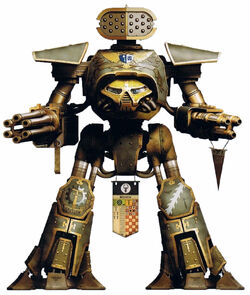
A Reaver-class Titan of the Legio Gryphonicus
The Collegia Titanica is organised into separate "divisiones" which each contains a number of Titan Legions (sometimes called "Titan Orders"). A Titan Legion is a group of Titans of different classes under the overall command of a "grand master," originating from a common Forge World or worlds.
Each Legio is bound by a common heritage, tradition and school of thought, and each possesses a distinctive code of conduct and their own predilection in regard to particular battlefield operation and employed tactics. Each Titan Legion also has a preference for the use of certain weapons, different uniform designs, Titan decorations, rank names, colours, heraldry, and other peculiarities.
All of this variety is within certain limits, as Titan Legions may not, for example, change the existing system of ranks and the Collegia Titanica's standard chain of command, though they still possess much liberty in their mode of operation -- similar, in ways, to the Chapters of the Adeptus Astartes.
Some Titan Legions were created to fulfill specific battlefield roles, such as assaulting siege works or combat in special environmental conditions, and thus are geared appropriately, both in terms of wargear and mindset.
The Collegia Titanica is the chief military arm of the Adeptus Mechanicus, and is beholden to that adepta's ruling Tech-priests. By virtue of the autonomy of the Mechanicus within the broader structure of the Imperium, the Titan Legions answer only to the Tech-priests' own hierarchy.
Their deployments and assignments are exclusively decided by the Mechanicus' senior magi, and each has to be authorised by the ruling lords of a Titan Legion's home Forge World. This right provides the magi with great influence over when and where Imperial armies making use of Titan support will fight.
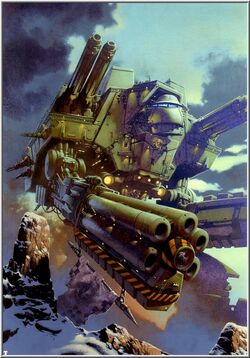
On the battlefield, Titans may not be issued orders by other Imperial military commanders, be they Astra Militarum or Adeptus Astartes officers. A Titan battlegroup's actions will only be decided by their commanding princeps, a ranking magos of the Adeptus Mechanicus accompanying them, or in some situations by the lords of the Forge World the Titan Legion hails from.
Although a high-ranking Tech-priest known as a magos technically holds authority over a Titan princeps, as they respect the princeps' tactical knowledge and experience, the latter would be given much freedom in their actions on the field. The magos, however, will interfere when they deem it necessary, for example ordering the battlegroup to withdraw from a world in order to avoid unnecessary Titan losses.
There is one exception to the above -- a full member of the Inquisition has the power to commandeer Titans already on the field and directly issue them orders, as well as to requisition the deployment of a Titan battlegroup from a Forge World. However, a wise and politically astute Inquisitor will be careful when interfering in Mechanicus business, and even more so because the Priesthood of Mars is understandably fiercely protective of the Titans they regard as divine incarnations of the Machine God.
The number of Titan Legions and individual Titans within the Collegia Titanica is unknown. Yet their ranks are presumed to be large. The Collegia Titanica has many deployments on its hands, protecting the Imperium not only from Traitors, but from xenos forces and other threats as well. Indeed, the Divisio Militaris deploys over a hundred Titan Legions to watch over the Eye of Terror alone, and the galaxy harbours many more dire threats to Humanity that require the attention of the Titan Legions.
In addition to these duties, the Titan Legions also take on expeditions which lead them away from the boundaries of the Imperium -- bringing new worlds into the Imperial fold, aiding Rogue Traders and Adeptus Mechanicus Explorator fleets.
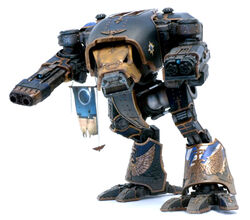
A Warhound-class Titan of the Legio Astorum
The number of Titans in a single Legio varies greatly, as some possess as few as a dozen, and others maintain well over a hundred. Battle losses take solar decades or even Terran centuries to replace, as the construction of a new Titan is a long and extremely labourious process for the Adeptus Mechanicus.
The Warlord-class is the most commonly found class of Battle Titan amongst the forces of the Imperium, while the Warhound is the smallest, utilised for scouting and flanking purposes. Between them stands the Reaver-class Battle Titan.
The towering Emperor Battle Titans, the size of great Imperial cathedrals, are by far the most formidable types of Titans ever deployed by the Imperium, but an increasingly rare sight on the battlefields of the 41st Millennium. Titan Legions are deployed only in the most vital campaigns of the Imperium and on battlefields where the terrain and circumstances will allow them to unleash the full power of their colossal weaponry.
Operation
Over the long millennia of constant warfare, the Titan Orders of the Collegia Titanica have developed their own tried and tested tactics and battle formations, many of which are based around the unit known as the "maniple." This is a configuration that makes use of Reaver and Warhound-class Titans, consisting of at least three god-engines of either class but up to five if they are available.
In a maniple formation, the Warhounds stride ahead of the Reavers, finding and marking targets to be destroyed by the advancing Titans. Some Titan battlegroups are in fact only comprised of maniples, and if such a force faces the need to divide its strength, it will create smaller units of near-identical configuration called "demi-maniples."
The Tech-priests accompanying a Titan battlegroup carry with them the equipment necessary to accommodate Titans engaged in heavy combat, and in addition to the performance of mundane battlefield maintenance, have the means to conduct minor field repairs.
The Tech-priests can facilitate the rearming of Titans in the event of the destruction of their original weapons load-out, or refit them with ordnance better suited for the task they face when battlefield conditions change.
Damaged Titans are taken after battle to the Tech-priests' facilities for repairs, but if during the course of fighting one of them sustains grave damage it will be withdrawn as soon as possible so as to avoid its untimely destruction, and given into the care of the Tech-adepts. If they prove unable to assuage the battered machine's pain, they will secure the ravaged Titan and return it to their home Forge World, where it may be given appropriate care.
Despite such precautions, the god-machines occasionally do fall in combat, much to the grief of the Cult Mechanicus and in particular the crews and staff that accompanied them. When a campaign is running its course, although saddened, the Forge World will send new Titans to replace the battlefield losses and to continue the fight.
The Divisiones
The Collegia Titanica has four "divisiones," the Divisio Mandati, the Divisio Telepathica, the Divisio Investigatus, and most importantly, the Divisio Militaris, which is the main fighting force of the Collegia Titanica.
The divisiones are further divided into a number of "Legions" or "Orders": groupings of Titans bound by a common heritage such as the Legio Ignatum or the Legio Gryphonicus. Each Titan Legion is a self-contained unit headed by an officer who is a princeps who holds the special rank of "grand master."
Divisio Militaris
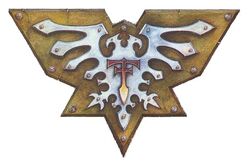
Badge of the Divisio Militaris
The Titan Legions of the Divisio Militaris, or as its Legios are more commonly called, the "Military Orders," are the main military force of the Collegia Titanica, and each includes its own support staff in addition to its Titans. Each Legio is based on its own Adeptus Mechanicus Forge World -- most Forge Worlds maintaining one, though others are known to harbour a larger number -- with Mars itself having three.
Although their home Forge Worlds are technically their bases, elements of the Titan Legions are actually stationed throughout the galaxy, guarding vulnerable locations across the Imperium.
Many Legios are stationed near the Eye of Terror, ready to combat their Chaos counterparts. Some of the Titan Legions of the Divisio Militaris are highly specialised forces, created to deal with siege works or undertake combat in exotic planetary environments.
Divisio Mandati

Badge of the Divisio Mandati
The Titan Legions of the Divisio Mandati are known as "Executive Orders." They travel in vast temple-spacecraft, responsible for bringing the Pax Imperia to isolated worlds of the Imperium. Each temple ship carries between two and five of the immense Emperor Titans, as well as Tech-priests, Mechanicus regular troops, maintenance adepts and support personnel.
Each Emperor Titan in the divisio is its own self-contained unit, carrying members of the Adeptus Arbites, the Inquisition and the other adepta of the Adeptus Terra.
With an Emperor Titan as their platform, servants of the Imperium can be very persuasive, and if that fails, they possess more than enough firepower to get their point across. It is through this combination of persuasion and potent threat that the Pax Imperia is brought to many new Human-settled worlds.
Some of the Executive Orders never leave the boundaries of Imperial space, confined to the dioceses left to their care. The elite of the Divisio Mandati's Titan Legions are known as "Missionary Orders" -- they travel beyond the borders of the Imperium, often accompanying Rogue Traders in discovering new worlds and regions of space to be settled and exploited by Mankind.
Divisio Telepathica

Badge of the Divisio Telepathica
Being highly specialised, the Divisio Telepathica is somewhat smaller than the Divisiones Mandati and Militaris. The Divisio Telepathica is responsible for the operation of the dreaded Psi-Titans, such as those of the Ordo Sinister, whom, judging by their known deployments, are specially designed to combat the forces of Chaos and the Traitor Titan Legions. Its Legios are called the "Telepath Orders," each operating from a secret Forge World near the heart of the Imperium.
The existence of Chaos is a closely-held secret of the Imperium, as are all those organisations like the Ordo Malleus and the Grey Knights devoted to combating it.
Since nearly nothing is known of the Divisio Telepathica, and because of their presumed dedication to combating the Ruinous Powers, it is not unlikely that it ranks alongside those esteemed servants of the Imperium as being entirely unknown by the greater populace of the galaxy.
Divisio Investigatus

Badge of the Divisio Investigatus
The Divisio Investigatus, whose Titan Legions are sometimes called "Research Orders," is the scientific research and development division of the Collegia Titanica. Its role is to construct the many war engines used by all the Titan Legions, and to engineer and test the rare improvements made in Titan technology by the increasingly stagnant Imperium.
At times, a Research Order takes part in battle so that it can test its new designs under proper combat conditions.
The Divisio Investigatus' Titan Legions favour the Warlord-class Titans, as their well-known handling characteristics and capabilities make them an ideal test-bed for the divisio's new devices.
Titan Formations
"The arming of Titans must, of necessity, always be a compromise. To gain heavy armament you must sacrifice speed and manoeuvrability, and vice versa. You must approach this decision at two levels. Firstly, the level of the individual Titan. Consider carefully what it much achieve, and how its armament will affect its ability to fulfil its objective. Secondly, the level of the force itself: this may be the Order as a whole, or the force dispatched for a particular mission. Never forget that a Titan force is a single body and may have specialised members constituted for specific functions. Meditate on the subject if you feel the need. The decision is of utmost importance and must not be taken lightly."
- —De Bellis Titanicus, attributed to Haran Jaxx
Maniples
Depending on their role, Titans are fully capable of operating individually, and often do so when supporting conventional ground units. In practice, they are often deployed in formations of anything from two to ten god-engines, but broken into formal units known as a "maniple" comprising three to five god-engines -- the numeral "5" having an occult and numerological signifier of destruction in many numiscantic systems of prognostication favoured by the Cult Mechanicus.
According to tradition, a maniple is made up of five Titans, although they may be divided (or, indeed, reinforced) into sub-maniples for the duration of a mission. There are countless configurations of maniples, as set out in the Libraxus Titanica, each being recorded in exacting detail along with countless footnotes detailing deployments, successes and failures.
The most commonly used maniple is called the Axiom. A Warlord Battle Titan leads the maniple, supported by a pair of Reaver Titans, while a pack of two Warhound Scout Titans ranges ahead to survey the battlefield. The Axiom maniple is widely regarded as the epitome of balance and tactical opportunity, but is only one among many maniple configurations, each with its own strength and tactical doctrines.
Command of a maniple is generally granted to the most senior princeps within it, although there have been notable exceptions. In any case, the elevated officer is granted the High Gothic rank of "princeps seniores" or "princeps senioris," which means a "senior princeps" in Low Gothic and is charged with dictating the maniple's strategic and tactical approaches.
The senior princeps' personality will shape the way the maniple hunts and fights, and as such the rank is highly sought after by ambitious princeps who wish to prove their worth.
Battlegroups
In conventional battles, the presence of a lone Titan -- even a Scout Titan class such as a Warhound-class Titan -- can be sufficient to guarantee victory. However, when Titans go to war en masse, they are formed into ad hoc groups, operating together under the command of their most senior princeps for the duration of a campaign.
All the units of a Titan Legion command deployed to a specific theatre are referred to as a "battlegroup." This is a loosely-defined term which can encompass one or more maniples of 3-5 Titans, individual Titans acting as reinforcements and any attached support units, such as banners of Imperial Knights from allied houses.
Notable Maniple Configurations
Axiom Battleline Maniple

Axiom Battle Maniple of the Legio Gryphonicus.
The Axiom maniple is one of the most sacred and well-regarded maniple configurations. It is both numerologically and strategically balanced, capable of dealing with almost any threat.
Mandatory Component
Optional Components
- One Reaver Battle Titan
- One Warhound Scout Titan
Myrmidon Battleline Maniple
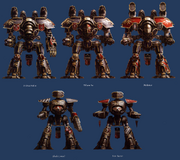
Myrmidon Battleline Maniple of the Legio Mortis.
There are very few enemies who can hope to stand against a Myrmidon maniple. Comprising the mightiest Battle Titans, it boasts sufficient firepower to damage a cruiser in low orbit.
Mandatory Components
- Two Warlord Battle Titans
- One Reaver Battle Titan
Optional Components
- One Warlord Battle Titan
- One Reaver Battle Titan
Venator Light Maniple
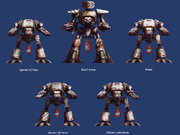
Venator Light Maniple of the Legio Krytos.
Where other maniples favour firepower and brute strength to overcome the foe, a Venator maniple puts emphasis on speed and opportunistic attack.
Mandatory Components
- One Reaver Battle Titan
- Two Warhound Scout Titans
Optional Components
- Two Warhound Scout Titans
Corsair Battleline Maniple
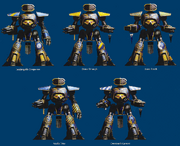
A Corsair Maniple of the Legio Astorum.
Corsair Battleline Maniples are built around a raiding doctrine, its Titans chosen for both their speed and fire power. The versatility of the Reaver-class Titan lends itself to this role -- swift enough to extract itself from danger but potent enough to win a protracted battle.
Mandatory Components
- Three Reaver Titans
Optional Components
- Two Reaver Titans
Janissary Battleline Maniple

Janissary Battleline Maniple of the Legio Atarus.
During the Great Crusade, Titans were often supported by large numbers of Knight banners. Janissary Batteline Maniples were developed to fill this role, bringing a balanced mix of war engines and crews skilled at fighting alongside Knight household units.
Mandatory Components
- One Reaver Titan
- Two Warhound Titan
Optional Components
- One Reaver Titan
- One Warhound Titan
Regia Battleline Maniple

Regia Battleline Maniple of the Legio Fureans.
Formations utilising paired Warlord Titans are common to many of the strategies of the Collegia Titanica. The Regia Battleline Maniple is perhaps the oldest of these, based upon the ancient concept of a king and queen and their court.
Mandatory Components
- Two Warlord Titans
- One Warhound Titan
Optional Components
- Two Warhound Titans
Lupercal Light Maniple
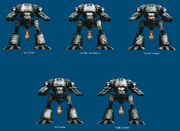
Lupercal Light Maniple of the Legio Krytos.
It is unclear if the Lupercal Light Maniple existed before Horus took command of the Great Crusade and its Titan Legions. However, its effectiveness was such that even after Horus' betrayal of the Emperor, both sides continued to use it extensively in battle.
Mandatory Components
- One Reaver Battle Titan
- Two Warhound Scout Titan
Optional Components
- Two Warhound Scout Titan
Fortis Battle Maniple
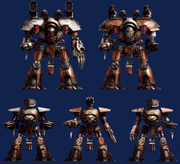
Fortis Battle Maniple of the Legio Fortidus.
Titans are mobile fortresses as formidable to bring down as any redoubt of steel and stone. The Fortis Battle Maniple was created as a defensive formation, allowing Titans to resist assaults from numerically superior foes or the massed firepower of enemy war engines.
Mandatory Components
- One Warlord Battle Titan
- Two Reaver Battle Titans
Optional Components
- One Warhound Battle Titan
- One Reaver Battle Titan
Ferrox Light Maniple

Ferrox Light Maniple of the Legio Crucius.
Collegia Titanica tactical doctrine teaches that lighter Titans must either support larger Titans or mass their firepower from the safety of cover. The Ferrox Light Maniple subscribes to a different tactical school of thought, striking in close for quick and destructive kills.
Mandatory Components
- One Reaver Battle Titan
- Two Warhound Scout Titans
Optional Components
- One Reaver Battle Titan
- One Warhound Scout Titan
Canis Light Maniple
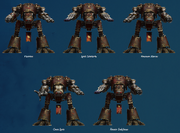
Canis Light Maniple of the Legio Audax.
Better known as a "Battle-Pack," Canis Light Maniples were perfected by the Legio Audax, utilising a Warhound's speed to launch brutal ambushes as they fall upon their prey with unbridled fury.
Mandatory Components
- Three Warhound Titans
Optional Components
- Two Warhound Titans
Arcus Battleline Maniple

Arcus Battleline Maniple of the Legio Praesagius.
A rarely observed maniple, Arcus Battleline Maniples were used against mobile enemy forces, relying on fast scouts to encircle the foe and direct the greater firepower of a Warbringer-Nemesis Titan.
Mandatory Components
- One Warbringer-Nemesis Titan
- Two Warhound Titans
Optional Components
- Two Warhound Titans
Ruptura Battleline Maniple

Ruptura Battleline Maniple of the Legio Praesagius.
Ruptura Battleline Maniples were formed to break open the most hardy of fortifications, its faster elements seizing every breach created by the Warbringer-Nemesis Titans in its complement before a counterattack could be organised.
Mandatory Components
- Two Warbringer-Nemesis Titans
- One Reaver Titan
Optional Components
- Two Reaver Titans
Mandatum Battleline Maniple
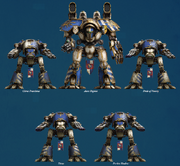
Mandatum Battleline Maniple of the Legio Praesagius.
Mandatum Battleline Maniples rely on intricate battleplans directed by the Warlord's princeps overseeing its subordinate Warhounds so they can maneuver into the perfect position.
Mandatory Components
- One Warlord Titan
- Two Warhound Titans
Optional Components
- Two Warhound Titans
Additional Titans
In times of need, a maniple can be reinforced by additional Titans, which may be seconded from another maniple or from the wider Legio. These Titans offer their support, and defer to the maniple's commanding princeps seniores, usually for the duration of a single mission.
A battlegroup can contain any number of additional Titans, other than those in the maniple.
Knight Household Support
When a Titan maniple goes to war, it is often supported by banners of Knights, compact war engines piloted by Nobles of the Knight houses, which use their speed and agility to scout ahead or secure battlefield objectives, broadening the strategic options available to a maniple's princeps seniores.
Warriors of the Collegia Titanica
Princeps and Moderati
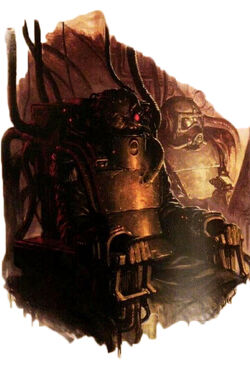
A high princeps of the Legio Astorum on the command bridge of his Reaver-class Titan.
Titan crews rank alongside the elite of the Imperial Navy in the skill with which they operate their mighty engines of war, although compared to the crews of void-faring warships they are few in number indeed.
The officer known as a "princeps" is in total command of the Titan via a Mind Impulse Unit, a complex and not entirely understood cybernetic device that merges the Human body and mind with the artificial intelligence of the god-engine so completely that a princeps controls the Titan's metal form as they would their own flesh. The process is a two-way one however, for each Titan, in particular the more ancient god-engines, is invested of its own individual, artificially intelligent "anima" which is the product of its deeds and the personalities of its former princeps, and which bleeds into the consciousness of the mind of its current princeps to create a gestalt of the two.
So immersive is this connection that should the Titan suffer damage, the princeps feels it as if their own flesh were wounded. Severe damage is likely to cause crippling stigmata on the princeps' body, and should the god-engine be dealt a killing blow, the cyber-neural feedback is almost certain to kill them as well.
Assisting the princeps are a number of specialist crew, the exact number present and their roles dependent on the class of Titan as well as the doctrines of the parent Legio. These officers are known as moderati (sing. moderatus), and each has responsibility for a different Titan system, such as the sensors, the helm or a specific weapon system, adding their own oversight towards the mind impulse commands of the commanding princeps.
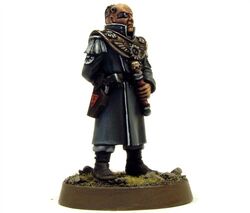
Several of these moderati are stationed at the princeps' side within the "head" of the god-engine, while others are located elsewhere in the Titan's mighty form -- the gun moderati, for example, are often stationed in the carapace as near to their weapons as the Titan's complex anatomy allows.
In addition, one or more Tech-priests watch over the god-engine's mighty Plasma Reactor, assisted by a small cadre of servitors. While a lighter class of Titan, such as a Warhound, might have but a handful of crew, a Warlord might have a dozen and an Imperator-class Titan even more.
As a result of the battles they come through together and because of their link to their Titan's Mind Impulse Unit, princeps and their moderati are often more closely knit than most families. Being linked to the MIU can also be dangerous and even lethal, as the potent Machine Spirit (artificial intelligence) of a Titan can wreck an unprepared individual's consciousness and drive them to madness.
Damage to the system's circuitry can cause the MIU to go haywire, and in such circumstances, the luckiest crew members are killed instantly by the psychic shock, while the rest are reduced to gibbering lunatics.
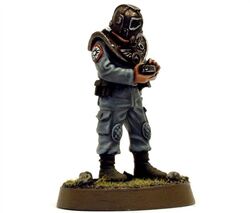
Most of the crews' own connections to the MIU are equipped with manual emergency cut-offs; however, sometimes the moderati and princeps are not able to utilise them quickly enough to avoid the damage. MIU links are attached via implanted cybernetic socket connectors in the cranium and neck, or in the body armour the crew wear. The armour's role is to shield them from secondary damage caused by shrapnel and impacts, and it additionally contains power and life support units, also attached by umbilicals to external devices.
These umbilicals have many redundant channels, so that if any one is severed in the heat of battle, another can easily take its place, making sure that nothing impedes the crew's ability to fight.
Infantry and Knight Support
Not all of a Titan Legion's subjects serve within the bodies of the mighty god-engines, for many more fight in their shadow. Each Forge World is served by massive cohorts of Skitarii, Secutarii and Adsecularis infantry troops, and these are often assigned to provide the Titan Legions with massed ground forces capable of performing the battlefield duties which the Titans themselves are too large to perform.
Furthermore, there are those Forge Worlds which, having compacted with subservient Knight houses of the Questor Mechanicus, march to war preceded by a fast moving skirmish line of Knight-Lancers and similar classes of combat walker that bridge the gap in size between infantry and Titan, engaging enemy vehicles and allowing the Titans to concentrate on the heaviest of enemy war machines, in particular enemy Titans.
It is when an army is to confront an enemy that is itself supported by Titans that they truly come into their own, and this only came about with the outbreak of the Horus Heresy. From the very outset, the Warmaster Horus ensured that as many Titan Legions as possible rallied to his banner and first amongst these was the Legio Mortis -- the "Death's Heads" -- and soon others followed.
Traitor Titans saw service in the very earliest battles of the Horus Heresy, including the Isstvan III Atrocity and the Isstvan V Drop Site Massacre. The Collegia Titanica was split asunder by the war and as it spread across the galaxy, the battlefields of the sundered Imperium burned with the staggeringly destructive potential of these mighty god-engines. The battle was never so bitter nor all-consuming however as when Traitor and Loyalist Titans faced one another in open war, the mortal soldiers fighting at their feet as inconsequential as insects and slain by the thousands as unimaginable energies were unleashed.
Tech-priests
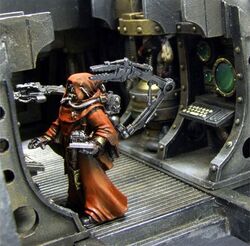
A Titan Tech-priest attending to his war machine.
Adeptus Mechanicus Tech-priests are charged with maintaining the Titan during the course of a battle, monitoring the state of the unstable and dangerous Plasma Reactor which is used to satiate the great machine's colossal power requirements, making sure that there is enough output to operate as many systems as possible, and that a catastrophic meltdown does not occur. In addition, the Tech-priest and their assigned servitors will tend to other devices present on the Titan, guaranteeing that they function to their best ability.
Amongst those devices are the Void Shield generators, which are a Titan's first line of defence. In the process of deflecting and absorbing hits, the generators build up a large excess of power, which eventually will cause them to shut down to prevent damage. A Tech-priest will attempt to withdraw as much as possible, at the same time carefully monitoring the reactor, so that the Titan does not take a direct hit.
However, when the Void Shields fail, the god-machine sustains structural damage. In such an event, the Tech-priest will immediately make sure that the reactor does not threaten meltdown, attempt to bring the Void Shield generators back on line, and then scan the Titan, searching for systems which have been disabled by damage, and try to repair them. In all these tasks, the Tech-priest is assisted by a number of servitors hard-wired into the god-engine.
Reverence
To the Cult Mechanicus, Titans are incarnations of the Machine God in the material realm, and possess a sacredness invested in them by virtue of their antiquity and technical complexity. The Tech-priests proclaim their divine nature by word and ritual. A thousand times blessed and consecrated with the holiest unguents, a Titan is a towering, walking idol to the Tech-priests of the Machine God. Many see the honour of serving aboard a Titan as an opportunity to serve the Omnissiah in person, and there is no greater service a mere mortal can perform.
Prior to being sent into battle, ceremonies are performed and the war engines are blessed. Exotic creatures are slain and their blood used to anoint each Titan's foot -- a symbol of the reality that they will soon lay blood at the Emperor's feet. During these rituals a senior Tech-priest will sprinkle the machine with sanctified oils and recite passages of the Prima Incubatoria.
These rites serve to rouse the Titan's Machine Spirit and prepare it for battle. A holy engine of destruction, a Titan's death is greatly saddening to all in the Cult Mechanicus. When one of their number falls, the rest will attempt to recover its ravaged hull and send it to their home Forge World, which will mourn its passing and toll a bell for each Titan lost.
Heraldry
Each Titan bears a distinctive and unique set of symbols. The Titan Legions use a complex and largely archaic system of decorations, icons and insignia to record a machine's past, as well as dedicating its Machine Spirit to the Emperor. Amongst those are banners flown from the Titan as well as markings and heraldry etched on the Titan's hull.
The following specifications lay out a minimum standard followed by much of the Collegia Titanica. However, every Titan Legion, and to lesser extent individual machines and their crews, have much freedom in designing their own decorations.
Crew Badges and Uniforms
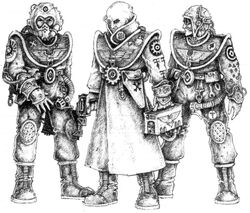
The uniforms and insignia of a Titan crew are largely specific to a given Titan Legion, as they are entitled to create their own designs. The body armour worn by Titan crewmen, in addition to granting protection, only has to accommodate two functions -- to allow for a cybernetic link to the Mind Impulse Unit, and to contain the necessary power and life support systems.
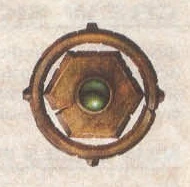
Princeps rank badge
Usually, a crewmember's rank badge will be displayed on his left shoulder, whereas the Titan Legion badge will be shown on the right. Some Legions also use a chest badge, and the symbol of a crewmember's rank will be attached to or hanging on a short chain from it.
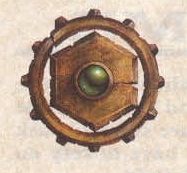
Senior Princeps rank badge
Personal decorations are not uncommon, especially amongst Moderati who mark their kills on their left sleeves. It is also common practise for Princeps to add their Titan's honours to their uniform. Some Titan Legions, however, choose not to display any decorations and insignia on their uniforms, believing that the markings their Titans bear convey all the required information.
Ranks
Titan crewmen, save for the war machines' attendant Tech-priests, are divided into four ranks. These are, in order of seniority, the Moderatus, the Princeps, the Senior Princeps, and the Titan Legion's Grand Master. Although such an event would be rather unlikely, in theory a Moderatus can advance through the ranks and one day become a Grand Master himself.
The Moderatus rank badge is in the shape of a plain circle surrounding a hollowed-out geometric figure -- if the Order the crewman belongs to utilises chest badges, in the amulet attached to it this shape will be socketed with a phased crystal gem which is used as a key to the Titan's controls. The Princeps and Senior Princeps also bear similar insignia, however the circles around their socketed gems have lugs added -- four and twelve, respectively.
A Grand Master's rank badge is unknown. However, when one takes to the field aboard his Titan and wishes to make his presence apparent, he is entitled to fly a banner bearing his Divisio's symbol. Some Legions use different names for these ranks, though none is entitled to change the system itself -- for example, some Titan Legions designate a Senior Princeps as a "High Princeps."
Hull Markings
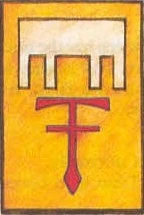
A Warhound-class Titan identification mark
Titan hulls are richly inscribed and decorated, as befits these physical avatars of the Omnissiah. This grows more true over time, as they are awarded honours for their performance on the battlefield, and their crews never miss an opportunity to etch a new commendation on the machine. The war engines also bear the personal heraldry of their Princeps. In the event of their death, the old commander's emblem would be removed and the new one's painted in its place.
The standard place for these heraldic sigils are, for Reaver-class Titans, the kneeplates, or for Warhound-class Titans, the carapace or leg plates. Although the colour scheme is constant for all Titans in a Legion, the decorations they bear are not. Machines of similar names (e.g. Canis Primus, Canis Secundus) will bear similar decorations, however, since those are very much the indication of the individual Titan, no two can be exactly alike. The war engine's head will often be inscribed with the name of the Titan, or, barring that, the name of its Legion. The hull will also display a gilded dedication to the Emperor, along with the Purity Seals the machine has earned during its service.
Titans can also be seen bearing identification marks. They are symbols etched on the Titan's legs where they can be clearly seen by ground level troops and provide them with information on what class of a Titan is towering over them. The Warhound identification mark is a rectangular shape standing on four unevenly spaced vertical legs, the Reaver mark is an axe facing leftwards, and the Warlord mark is two crossed axes. Imperator-class Titan identification marks are presently unlisted in Imperial records.
Banners
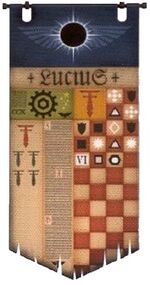
Legio Astorum Princeps Honour Banner
The banners flown from the Titan contain much information on its origin, history and feats, its past and present, the information essential to what the Titan is. These banners are very much prized Imperial relics in their own right, and will be taken down from the machines to which they belong prior to battle in order to preserve them.
This means that for most of the time, the banners are stored on the Titan Legion's homeworld, or follow the Titans on their deployments to warzones stashed safely behind the front lines in the resupply and refit facilities set up by the Tech-priests accompanying the war machines.
Honour Banners
The Honour Banner is the most prominent banner flown from a Titan, bearing the symbol of the Legion it belongs to and displaying the rank of the Princeps in command of it. It also usually displays the individual Titan's honours and battles won. The Honour Banner has the following form: it is split into two horizontal bands on the top of the Banner, the rest being split into two vertical bands of equal size. The left vertical band is further split in a similar fashion, one horizontal band on top and two vertical bands below.
The larger horizontal bands bear, top to bottom, the emblem of the Titan Legion the machine belongs to, and the name of its home Forge World. Some Titan Legions, however, choose to display the Legion's name instead, and some individual Titan banners can be seen displaying their revered machine's name altogether. Further, the right vertical band contains a listing of the battles the Titan participated in and won (likely under its current Princeps), broken down by the type of enemy they faced – these markings being entirely invented by a given Legion.
On the left vertical band, the top horizontal section displays the rank of the Princeps in command of the Titan, as well as recording past Princeps, if only by number. On the leftmost vertical band, the Titan's individual honours are listed in the form of arrayed "T" symbols. The vertical section located to the right contains a High Gothic litany of deliverance from danger, and dedicates the war engine to the Emperor.
Kill Banners
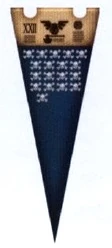
Legio Astorum Moderatus Kill Banner
The Kill Banner displays the Titan-class kills attributable to the actions of an individual Moderatus. The Kill Banner usually takes the shape of a triangle, with a top section bearing decoration used to differentiate each Moderati's banner, and the lower section listing the kills -- usually in the form of skulls.
If there is only one Gun Moderatus aboard a Titan, only one banner will be flown. The Moderati religiously mark their feats on their banners, as a form of service to the Titan, and in extension, to the Machine God.
Heresy Banners
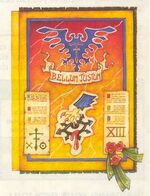
Legio Gryphonicus Heresy Banner
During the dark days of the Horus Heresy, fully half of the Collegia Titanica's Titan Legions declared their allegiance to the rebel Warmaster Horus in his bid for power over Mankind. Those Titans that have remained loyal to the Emperor during that grim time -- and survived -- gained the right to fly so-called "Heresy Banners," as a display of their steadfast loyalty to the Imperium.
The banner, in addition to decoration specific to a given Titan Legion, bears the Divisio Militaris eagle, the Legion's campaign motto, citations and honours from battles the Titan has taken part in, and purity seals it has been awarded during this period.
Notable Loyalist Titan Legions
- Cyclopeans
- Firesword Legion
- Imperial Eagles
- Imperial Fists (Titan Legion)
- Legio Absolutium
- Legio Adamantus
- Legio Aeris Aestus
- Legio Agravides ("Battle Scourges")
- Legio Amaranth ("Night Spiders")
- Legio Annihilator
- Legio Arconis ("Iron Kings")
- Legio Astorum ("Warp Runners")
- Legio Astraman ("Morning Stars")
- Legio Atarus ("Firebrands")
- Legio Atrox
- Legio Bombastor
- Legio Castigatra
- Legio Castigatum
- Legio Confindo ("Sun Cleavers")
- Legio Crucis
- Legio Crucius ("Warmongers")
- Legio Debellator
- Legio Decimata
- Legio Defensor ("Nova Guard")
- Legio Destructor ("Beasts of Steel")
- Legio Dominatus
- Legio Excruciata
- Legio Ferrax ("Iron Wolves")
- Legio Ferocastrum ("The Holdfasts")
- Legio Ferroxus
- Legio Fortidus ("Dauntless")
- Legio Fortis
- Legio Fortitudis
- Legio Fulminari
- Legio Gigantes
- Legio Gladius
- Legio Gryphonicus ("War Griffons")
- Legio Honorum ("Death Bolts")
- Legio Ignatum ("Fire Wasps")
- Legio Ignis ("Fire Kings")
- Legio Interfectra
- Legio Intrafex
- Legio Invicta
- Legio Invigilata ("Emperor's Guard")
- Legio Kaurthos
- Legio Lacrimae
- Legio Lysanda ("Sentinels of the Edge")
- Legio Maledictis
- Legio Manus Flameaus
- Legio Metalica ("Iron Skulls")
- Legio Mortis Metallum
- Legio Naesseas ("Deep Dwellers")
- Legio Nivalis ("Ice Giants")
- Legio Oberon ("Death Bolts II")
- Legio Officium
- Legio Ordo Canis ("Head Hunters")
- Legio Osedax ("Cockatrices")
- Legio Pallidus Mor ("Pale Riders")
- Legio Perennia
- Legio Praesagius ("True Messengers")
- Legio Praesidium Vortex
- Legio Praetor
- Legio Sirius
- Legio Solaria ("Imperial Hunters")
- Legio Tempestus ("Stormlords")
- Legio Tenerii
- Legio Thanataris
- Legio Ultima
- Legio Venator ("Iron Spiders")
- Legio Victorum ("Foe Slayers")
- Legio Vindictus
- Legio Xerxes
- Legio Xestobiax ("The Iron Vigil")
- Ordo Sinister ("Nightmare Titans")
Notable Traitor Titan Legions
- Adamant Fury
- Burning Stars
- Festering Death
- Forsaken Reavers
- Ironclast
- Riotous Host
- Silver Scythes
- Suns of Damnation
- Legio Abhorrax
- Legio Abominator
- Legio Argentum ("Dread Lances")
- Legio Audax ("Ember Wolves")
- Legio Covenentia
- Legio Damicium ("Unbroken Lords")
- Legio Damnatus ("Warped Dogs")
- Legio Damnosus ("Lords of Ruin")
- Legio Excruciatus ("Helldogs")
- Legio Frostreaver
- Legio Fureans ("Tiger Eyes")
- Legio Interfector ("Murder Lords")
- Legio Krytos ("God Breakers")
- Legio Kulisaetai ("Gatekeepers")
- Legio Kydianos ("Death Cry")
- Legio Lacrymea ("Harbingers of Grief")
- Legio Laniaskara ("Impalers")
- Legio Magna ("Flaming Skulls")
- Legio Metallum Armaturum
- Legio Morbus
- Legio Mordaxis ("Deathdealers")
- Legio Mortis ("Death's Heads")
- Legio Onerus
- Legio Pestis
- Legio Phasma
- Legio Proditor
- Legio Serpentes
- Legio Suturvora ("Fire Masters")
- Legio Tempestor ("Stormlords")
- Legio Ulicon
- Legio Ulricon
- Legio Ursa
- Legio Vendettica
- Legio Vulcanum I ("Dark Fire")
- Legio Vulcanum II ("Lords of Ruin")
- Legio Vulpa ("Death Stalkers")
- Legio Vulturum ("Gore Crows")
- Legio Vulturus
- Legio Xestobiax ("Iron Vigil")
Notable Blackshield Titan Legions
- Legio Tritonis ("Dark Tide")
- Blood Hounds of Gryrut
- Cleansing Flame
- Hounds of Night
- Protectorate of Unsubdued Steel
- Pretermitted Brotherhood
- Lords of Valour
Videos
See Also
- Titans
- Titan Legions (List)
- Imperial Titans (List)
- Chaos Titan
- Chaos Titans (List)
- Titan Weapons
- Traitor Titan Legions
- Imperial Knights
Sources
- Adeptus Titanicus (1st Edition), pp. 2, 5, 6-7, 18, 29, 51
- Adeptus Titanicus - The Horus Heresy: Rulebook (Specialty Game), pp. 9-12, 14-17, 53-54, 57, 59, 61-62
- Adeptus Titanicus - The Horus Heresy: Titandeath (Specialty Game), pp. 60, 62, 64, 66
- Adeptus Titanicus - The Horus Heresy: Doom of Molech (Specialty Game), pp. 30-31
- Adeptus Titanicus - The Horus Heresy: Shadow and Iron (Specialty Game), pp. 40-43
- Adeptus Titanicus - The Horus Heresy: Crucible of Retribution (Specialty Game), pp. 6, 26-27, 30, 52-53
- Adeptus Titanicus - The Horus Heresy: Loyalist Legios (Specialty Game), pp. 18-165
- Adeptus Titanicus - The Horus Heresy: Traitor Legios (Specialty Game), pp. 18-161
- Citadel Journal 21, "Machines of Destruction: Titan Upgrades"
- Codex: Eye of Terror (3rd Edition), pg. 16
- Codex Titanicus (1st Edition), pp. 4, 7, 13, 15, 18, 22-23, 26-27, 30
- Epic Titan Legions: Codex Titanicus (2nd Edition) by Andy Chambers, pp. 19-20
- Imperial Armour Volume Three - The Taros Campaign, pg. 251
- Imperial Armour Volume Six - The Siege of Vraks - Part Two, pp. 34-35, 42, 48, 53, 60, 79, 83-84, 112-113, 118, 199
- Imperial Armour Volume Seven - The Siege of Vraks - Part Three, pp. 37, 49, 88, 205-206
- Imperial Armour Volume Ten - The Badab War - Part Two, pp. 44, 50
- Imperial Armour Volume Eleven - The Doom of Mymeara, pp. 18-19, 36, 39, 50-51, 56, 106
- Imperial Armour Update 2006, pg. 5
- Imperial Armour Apocalypse II, pg. 39
- The Horus Heresy - Book Three: Extermination (Forge World Series) by Alan Bligh, pg. 161
- The Horus Heresy - Book Four: Conquest (Forge World Series) by Alan Bligh, pp. 146, 242, 294
- The Horus Heresy - Book Five: Tempest (Forge World Series) by Alan Bligh, pp. 257-264
- The Horus Heresy - Book Six: Retribution (Forge World Series) by Alan Bligh, pp. 16, 62, 81, 114
- The Horus Heresy - Book Seven: Inferno (Forge World Series) by Alan Bligh, pp. 101, 280-282, 286-291
- Titan Legions (2nd Edition), pp. 11-16, 19
- Warhammer 40,000: Apocalypse, pg. 124
- Warhammer 40,000: Rulebook (4th Edition), pg. 121
- Mechanicum (Novel) by Graham McNeill
- Soul Hunter (Novel) by Aaron Dembski-Bowden
- The Ember Wolves (Short Story) by Rob Sanders
- Heralds of the Siege (Anthology) edited by Nick Kyme and Laurie Golding, "Myriad" by Rob Sanders, pp. 11-40
- The Horus Heresy: Collected Visions by Alan Merett, pp. 354-362
- Titandeath (Novel) by Guy Haley, Ch. 12 (Quote)
- White Dwarf 194 (UK), "Abominatus - Destroyer of Worlds," by Adrian Wood, pp. 39-43
- White Dwarf 190 (UK), "Slaanesh War Machines - Chaos Titans"
- White Dwarf 188 (UK), "Stomp an' Smash! - Fires of Gehenna"
- White Dwarf 186 (UK), "Eldar Revenant Scout Titans"
- White Dwarf 181 (UK), "Imperator Titan: Tactics"
- White Dwarf 180 (UK), "Fists of Death: Titan Tactics"
- White Dwarf 179 (UK), "Titan Legions: Epic Miniatures" & "Inferno: Fires of Gehenna"
- White Dwarf 178 (UK), "The Titan Legions," by Rick Priestley
- White Dwarf 177 (UK), "Titan Legions: Preview"
- White Dwarf 175 (UK), "Questions and Answers 2 - Titans"
- White Dwarf 173 (UK), "Questions and Answers - Titans"
- White Dwarf 171 (UK), "Chaos Armies - Chaos Titans"
- White Dwarf 170 (UK), "Epic: Eldar Armies - Titans"
- White Dwarf 164 (UK), "The Banelord: Chaos Titan of Khorne"
- White Dwarf 148 (UK), "Daemons & Chaos War Machines"
- White Dwarf 144 (UK), "'Eavy Metal: Epic Vehicles and Titans" & "Titan Data Sheets"
- White Dwarf 142 (UK), "Titan Weapons"
- White Dwarf 133 (UK), "Titan Expansions"
- White Dwarf 124 (UK), "Codex Titanicus Errata"
- White Dwarf 120 (UK), "War Griffons: Colour Schemes & Markings"
- White Dwarf 117 (UK), "Codex Titanicus: Preview"
- White Dwarf 116 (UK), "Imperial Vehicles - Imperial Data Cards: Codex Titanicus"
- White Dwarf 114 (UK), "Death Blow! Advanced Damage Rules"
- White Dwarf 111 (UK), "Epic 40K: Craters,"
- White Dwarf 110 (UK), "Eldar Phantom Class Titans: Shade & Spectre Variants,"
- White Dwarf 109 (UK), "Reavers and Warhounds,"
- White Dwarf 108 (UK), "'Eavy Metal: Adeptus Titanicus Titans & Banners,"
- Third War for Armageddon Worldwide Campaign
- Warhammer Community - Adeptus Titanicus Part 1: What Is Adeptus Titanicus? (06 Aug 2018)
- Warhammer Community - Adeptus Titanicus Part 2: The Horus Heresy (07 Aug 2018)
- Warhammer Community - Adeptus Titanicus Part 3: War on a New Scale (08 Aug 2018)
- Warhammer Community - Adeptus Titanicus Part 4: Getting Started (09 Aug 2018)
- Warhammer Community - Adeptus Titancus Part 5: Miniatures Showcase (10 Aug 2018)
- Warhammer Community - Adeptus Titanicus Part 6: The Titan Legions (14 Aug 2018)
- Warhammer Community - Adeptus Titanicus Part 7: Founding a Titan Legion I (15 Aug 2018)
- Warhammer Community - Adpetus Titanicus Part 8: Strategems and Battlefield Assets (16 Aug 2018)
- Warhammer Community - Adeptus Titanicus Part 9: A Trip Down Memory Lane (21 Aug 2018)
- Warhammer Community - Adeptus Titanicus Part 10: Founding a Titan Legion II (22 Aug 2018)
- Warhammer Community - Adeptus Titanicus Part 11: Reaver Battle Titans (28 Aug 2018)
- Warhammer Community - Adeptus Titanicus Part 12: Warhound Scout Titans (02 Oct 2018)
Gallery
| Titans | |
|---|---|
| Scout Titans | Rapier-class Titan • Warhound-class Titan (Wolf-class Titan • Mastiff-class Titan • Jackal-class Titan) |
| Heavy Scout Titans | Dire Wolf-class Titan |
| Battle Titans | Reaver-class Titan • Carnivore-class Titan • Mirage-class Titan • Komodo-class Titan • Executor-class Titan • Warbringer Nemesis-class Titan • Punisher-class Titan • Warlord-class Titan (Death Bringer-class Titan • Eclipse-class Titan • Nightgaunt-class Titan • Nemesis-class Titan • Warlord-Sinister-class Psi-Titan) • Siege Titan • Apocalypse-class Titan |
| Heavy Battle Titans | Warmaster-class Titan (Warmaster Iconoclast-class Titan) |
| Emperor Titans | Imperator-class Titan • Warmonger-class Titan |
| Chaos Titans | Subjugator Scout Titan • Questor Scout Titan • Feral-class Titan • Ravager-class Titan • Banelord-class Titan • Plaguelord-class Titan • Painlord-class Titan • Warplord-class Titan |
| STC Titan | Castigator-class Titan |



